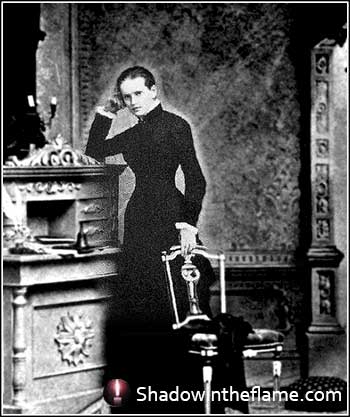This is the Author’s Interpretation of the Ideas & Philosophy Behind
“The Man”
Chapter 3

In Chapter 3 The Man is in emotional crisis when he comes face to face with immortality and the hopelessness of his life. We don’t know what triggered his predicament but I feel he has reached the same depths of despair that Nietzsche confronted in 1881/82. So to help set the scene for the emotional crisis The Man is experiencing I would like to describe to you what happened to Nietzsche in real life.
Nietzsche’s 18 Month Crisis
Up until the summer of 1881 Nietzsche had lived an ascetic (an austere, abstinent, frugal) and lonely life punctuated by bouts of illness, depression and euphoria as well as short periods of happiness, such as when he was invited to stay with a wealthy benefactor.
In the 18th and 19th century many wealthy people would often collect talent such as writers, poets and composers and invite them as house guests for entertainment during their summer vacation. While the accommodation, food and company on these occasions were in stark contrast to Nietzsche’s normal fare it must have made going back to his lonely rooms even more miserable when the patron dusted them off the end of the holiday.
Nietzsche knew he was an outstanding thinker and writer but he was distressed that most people did not recognize his genius and he was devastated that practically no one bought the books he wrote. Nietzsche self published his books in small runs of one or two hundred paying the printer out of his meager disability pension from Basle University.
Nietzsche’s Nomadic Life
Nietzsche had no fixed home but followed the sun, constantly moving from one city to another and one cheap room to another wherever he felt the climate was better for his health. Leading this nomadic lifestyle he accumulated few personal effects and even fewer close friends. He felt isolated and unloved.
Most of all, the loneliness got him down. The feeling that there was no one to share his life with, no one who cared if he was sad or happy, no one to discuss his ideas with on a personal and intimate level, no one to kiss, no one to cuddle and hold tight to him. He missed the quiver that sexual desire for the one you love triggers in your groin as well as the happiness you feel when they walk into the room. He was lonely and he hated it.
But he never surrendered to despair but rather worked through his feelings in his books where he set out to discover the formula for happiness.
“I am still living, I am still thinking: I have to go on living because I have to go on thinking. Sum, ergo cogito: cogito, ergo sum.”
Nietzsche wrote this on New Year’s Day 1882 and as we saw in my previous post “Sex and The Philosopher who specialized in feeling Wretched” this was at the beginning of a terrible period in his life which encompassed the eighteen months from the summer of 1881 to the beginning of 1883 when the woman he believed was his soul mate, the first one he could discuss his ideas with on an equal footing, the one he loved and hoped to marry, dumped him.
To help you imagine how he felt, I am sure most of you can look back and find a really low period in your life when your worries or your depressed state physically and emotionally drained you possibly to the point where you were physically sick. Some people actually end up in hospital when they reach this point and Nietzsche was close but instead he withdrew to an isolated village in the mountains where he took a spartan room and spent many hours everyday walking the slopes and valleys.
It is a time when you continually go over and over in your mind, “if I had done this or said that, things would have been different”. You desperately need to put an end to the issue, come to an understanding with it before you can move on but it can be a long and painful experience.
“I am still living, I am still thinking: I have to go on living because I have to go on thinking” sums up that feeling as succinctly as I have ever heard it put and it also sums up where The Man is at the moment.
I Don’t Want to be Lonely Anymore!

Lou Salome
In April 1882, Nietzsche wrote a love letter to Lou Salome which he ended with the words
“I don’t want to be lonely any more; I want to learn to be a human again. Alas, in this field I have almost everything still to learn!”
You can imagine the ecstatic heights he rose to when she agreed to visit him for a holiday. He planned to propose to her, he was, in true Nietzsche style, deliriously happy. Imagine then the abyss into which he plunged a few weeks later when she abandoned him to run off with Ree, his best friend.
This is what the main character in our novel “The Man” is going through although we do not yet know the reason why. He has entered a similar period of despair and self evaluation. In fact I am not sure if The Man has yet reached the depths of depression that Nietzsche experienced, but he is obviously struggling.
The beginning of the chapter contains a lot of symbolism about life. The cars in the yard that are either being stripped or repaired, “the owner long ago forgot which” represent the things we start in life but never complete. The New Year Resolutions we make but never keep. The promises we whisper in the ear of a lover that never get fulfilled.
The girls playing hopscotch with no lines to mark out the squares represents the way we embark on relationships without seeing each others boundaries or even knowing where they are. We dance with love never knowing when it will trip us up but we don’t care, we are in love.
End of Part 1 – I don’t Want to Be Lonely Anymore – an analysis of The Man Chapter 3
Ric Vatner
The Man, A Philosophical Novel – The Chapters So Far:
Read an Analysis of Each Chapter – The Philosophy and Ideas behind the Story

